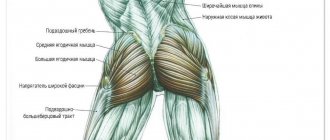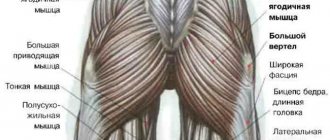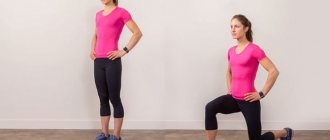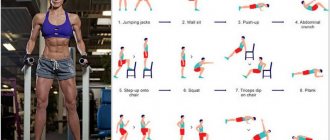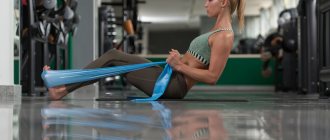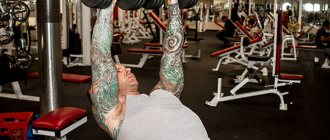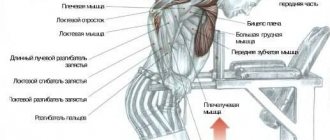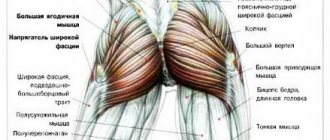You already know what a barbell looks like and what you need to do on a Scott bench. Now it's time to start an adult conversation about what your workout should be like and how to properly shape and pump up your muscles.
You are no longer new to the gym, and you can even distinguish a pronated grip from a supinated one, however, all this is child’s play, and it’s time for you to learn everything about how to pump up your body at any age, even at 20 or 40 years old.
A complete guide from a professional to creating an intensive, smart training program. You'll learn concepts such as training load and volume, and learn how to optimize your workouts to achieve maximum results. The training complex for the whole body will be divided into 3 days according to the split format:
- How to pump up your chest and back muscles
- How to pump up the muscles of your shoulders and legs
- How to pump up arm muscles
How to quickly build up body muscles
The initial desire “I want to pump up”, thanks to which you got into the gym in the first place, should grow over time and transform into the desire to pump up correctly and avoid unnecessary injuries. Proper muscle development is based on knowledge of technique, load distribution, volumes, well-structured rest intervals and knowledge of body biomechanics.
When determining the intensity level to create an effective training program for the advanced, there are three things you need to think about first. These are volume, loads and avoiding overtraining.
Using different weights and different numbers of sets can be difficult, but it will allow you to overcome plateaus and not just build muscle properly, but maximize your genetic potential.
These variations can also change as you train different parts of the body, depending on your individual weaknesses.
Your goal in building your individual periodization strategy should be to reach an optimal level of training, accompanied by the effect of supercompensation. At this stage, you can plan no more than 3-4 strength exercises per week with the addition of supporting activities: yoga, cardio, stretching, trekking, swimming, etc. to improve your aerobic and general endurance.
The structure of strength training can be built in a split format, dividing the work of target muscle groups on different days, or follow circuit training for the whole body. In our article we recommend split training. Try this intensive three-day program for more advanced athletes.
Chest and back muscle training
We recommend starting each strength training session by working the abdominal muscles with one or two exercises. This way you will warm up your body perfectly and effectively load one of the most important muscles - the rectus and oblique abdominal muscles.
Features of training
Nowadays, there are a huge number of techniques that allow you to build muscle mass directly at home. But the main guideline for a beginner should be basic multi-joint exercises. They use several muscle groups at the same time. As a result, muscles develop better when properly restored.
One of the best exercises for the upper body, especially the back and arms, is the pull-up. Grasp the crossbar with an overhand grip. Initially, you need to hang a little - this will allow you to stretch the muscles. Then you need to begin to pull yourself up smoothly. The chin should be higher than the bar at the end point. After three or four workouts, you can hover for a few seconds at the top point. This will increase the tension on the latissimus dorsi muscles.
To stimulate testosterone growth, you should also do squats. To do this, you can use dumbbells or a barbell. Beginners can start training with squats without weights.
Push-ups are used to pump up the pectoral muscles. Statically, this exercise involves all muscle groups. You need to start doing push-ups with your hands approximately shoulder-width apart. Over time, this exercise can be replaced with a bench press with dumbbells or a barbell.
The press deserves special attention. It's not easy to pump it up. You can raise your legs to a horizontal position, holding the bar with your hands, or do crunches. This will strengthen your abdominal muscles. However, they will only be visible with a low percentage of body fat.
All exercises are first performed ten times in two approaches. After a few days, the number of repetitions is increased to fifteen, then to twenty. After this, the number of approaches is increased. After two weeks, the exercise cycle is repeated twice. Rest between sets - at least a minute. Otherwise, too many calories will be consumed and the person will become tired prematurely.
When twenty push-ups in four to five approaches are easy, you can start working on the uneven bars. It is advisable to perform this exercise after pull-ups. Ideally, it is better to start your workout with squats. This will give you a good stretch for your entire body. The main thing is to monitor your breathing. Your back should be straight when squatting. After this, the exercises move on to pull-ups, then to dips, and finally, hanging leg raises, pumping up your abs.
Such training should initially be carried out three times a week. For example, on Monday, Wednesday and Friday. Or you can choose three other days. The main thing is that you don’t feel severe muscle pain during your next workout. After all, you should understand that muscles grow precisely when they fully rest and recover. Here it’s all about nutrition and daily routine.
Of course, such training will be less effective than in a gym, where appropriate equipment is provided. But by strictly following the rules, you can practice efficiently and eventually achieve your planned goals. If you use dumbbells or a barbell in your workouts, it’s better to get a partner. If necessary, he must provide insurance. All exercises should be performed until muscle failure. This will allow you to fully utilize muscle fibers. There is no need to be distracted by external stimuli. To focus on your workout, you can put on headphones and turn on your favorite music.
The main rule of home training is consistency. Systematic training will definitely give the desired result, which will be noticeable. If you train properly with your own weight, you can significantly change your physical shape within a month. Additional weights of up to forty kilograms will help pump up the muscles of the back, chest and entire shoulder girdle.
If a person lives in a private house or has his own room, then you can equip a small gym to strengthen and improve the body. To get started, just buy collapsible dumbbells or a barbell, a bench press with an adjustable angle and the ability to change the height of the racks. This will allow you to perform various pressing exercises. For example, bench press of a barbell or dumbbells, standing, lying down, at a certain angle. Adjusting the racks will make it possible to squat with a barbell. This exercise dramatically builds muscle mass. Even if you do it once a week, gradually increasing the load, you can notice the effect over time.
Achieving your goal is not difficult. The main thing is to gather willpower into a fist and make maximum use of all the capabilities of the body. Systematic adherence to the above recommendations will help you change your body shape for the better in a month.
Hi all. Not all of us can afford to go to the gym regularly. There are also those who are forced to train at home. In this article we will figure it out.
Many will say that studying at home is just a waste of time. This is, of course, not true. You probably won’t be able to become Schwarzenegger, but it’s quite possible to gain athletic shape and become thoroughly stronger.
So, how to build muscle at home?
without any special equipment? First, let's look at the set of necessary exercises. Many people mistakenly believe that the arsenal of a home jock is limited to push-ups and crunches. This is far from true.
The presence of a horizontal bar and a pair of dumbbells significantly expand the arsenal of a home muscleman. And if there is a barbell, then that’s totally cool. If you really want, you can make a barbell and dumbbells yourself. My first barbell was a wooden stick with two bricks at each end. And I made dumbbells from large gears from a sawing machine.
Let's start by looking at exercises for the pectoral muscles. And the first exercise for home training is, of course, push-ups
.
There are many options for performing this exercise. I will not go into detail here; I will only describe classic push-ups aimed at maximizing the development of all parts of the pectoral muscles. In order not to miss the full course on push-ups, subscribe to blog updates
.
So, to perform push-ups, place your hands about 30 cm wider than your shoulders (15 cm on each side). Feet together, resting on toes. Arms are straightened, back is straight. This is our starting position.
Slowly lower yourself down until your chest touches the floor, then powerfully straighten your arms and return to the starting position. We perform the exercise the planned number of times. In each approach, it is enough to do 10-12 repetitions. If you can do more, you need to increase the weight. A hiking backpack containing a sandbag is ideal for this. Thanks to this, you can always choose the right weight.
The second exercise for developing chest muscles is pullovers
. You can read about them. At home, instead of dumbbells, you can use the same sandbag, plastic water bottles or bricks wrapped with tape.
If you have a workout area in your yard, then you are generally lucky. In this case, the training of the pectoral muscles can (should) be diversified. In addition, this exercise works great on the triceps. Since we are talking about training the triceps, I will say that there is an excellent exercise for their development - push-ups with a narrow position of the hands (grasshopper push-ups).
Next, let's start training the back. For this we need a horizontal bar. This is not a problem now. A large number of different crossbars for doorways are sold. It's convenient and you don't have to run outside. About pull-ups
I also wrote earlier, I won’t repeat myself. For those interested, take a look.
Arm training
. The biceps are well-loaded when doing pull-ups. And of course, various arm curls with weights. If you don't have dumbbells and barbells, use the same large water bottles.
And, of course, every workout should end with abdominal exercises. There are also a lot of them, but they are all based on one thing - twisting the torso. You can read about training the abdominal muscles.
We have decided on a set of exercises. Now let me give you an example of a training program
for practicing at home. We will train 3 days a week.
Monday:
Pushups
– 5 sets of 10-12 reps
Push-ups with narrow arms Pull-ups
– 5 sets of 10-12 reps
Weighted arm curls
– 5 sets of 10-12 reps
Crunches
– 3-4 sets of 25 reps
On Wednesday
and
Friday
we repeat this program. This is an example training program. It is good for the initial stage of training. As you gain experience, you will be able to independently create training programs and adapt to your body.
I hope I answered the question of how to build muscle at home
.
In the near future I will write a super-effective program for gaining muscle mass
, so I advise
you to subscribe to blog updates
so as not to miss all the most interesting things.
PS
.
By the way, I advise you to familiarize yourself with the nuances of the technique
of basic exercises in.
Day 1 - Chest and Back
Body Twist - Russian Twist
- 4 sets of 20 reps
- Body Part: Press Equipment: No
Incline Dumbbell Press
- 4 sets of 12,10,8,8 repetitions
- Body part: Chest Equipment: Dumbbells
Dumbbell flyes lying on an incline bench
- 3 sets of 10-12 reps
- Body part: Shoulders Equipment: Dumbbells
Bringing hands together in crossover
- 3 sets of 12 reps
- Body Part: Chest Equipment: Block
Pull-ups
- 4 sets of 12,10,8,8 repetitions
- Body Part: Lat Equipment: Bodyweight
Reverse grip pull-ups
- 3 sets of 8-10 reps
- Body Part: Lat Equipment: Bodyweight
Downward pull of the upper block
- 3 sets of 10-12 reps
- Body part: Lat Equipment: Block
Add to Calendar * Add to My Workouts * Print Workout
* — The service is in beta testing
Shoulder and leg muscle training
Today is the main day of the week and you are working some of the most difficult muscles. Starting traditionally with the abs, I recommend doing 2-3 shoulder exercises at the beginning of your workout. This will allow you to accurately control the trajectory of movement, better feel your body and avoid losing control of the technique.
If desired, add a seated dumbbell press, a military press, or a Smith machine to the complex for a general workout of all the shoulder girdles.
Day 2 - shoulders and legs
Crunches
- 4 sets of 20 reps
- Body Part: Press Equipment: No
Raising dumbbells in front of you
- 3 sets of 10-12 reps
- Body part: Shoulders Equipment: Dumbbells
Standing dumbbell lateral raises
- 2 sets of 10-12 reps
- Body part: Shoulders Equipment: Dumbbells
Elevated Back Lunges
- 3 sets of 12-15 reps
- Body part: Quadriceps Equipment: Barbell
Lunges with barbell to the side
- 3 sets of 12-15 reps
- Body part: Quadriceps Equipment: Barbell
Smith machine deadlift with straight legs
- 4 sets of 15 reps
- Body part: Hamstrings Equipment: Exercise
Add to Calendar * Add to My Workouts * Print Workout
* — The service is in beta testing
Arm muscle training
At the end of the week, you will have the most enjoyable training. Your arms have been waiting in reserve and feel great after a few days of break after training the pectoral muscles and back, where their role was high. Start with the abdominal muscles and gradually move from joint to isolation exercises. It is advisable to finish with forearm training and a good warm-up.
How to pump up in 1 week in the gym
If you have the opportunity to visit the hall, then you are lucky. After all, in the gym using special equipment it is easier and faster to do this, especially if we want to pump up in a week.
On the first day, it is important to focus on the back:
- Chest press – do 12 times for 6 approaches. We do the first approaches in a horizontal position, the next it is important to use an inclination. The hall has special benches at an angle.
- Cravings for the stomach. Here we use a barbell. You need 4 sets of 12 times. It is very important that your back remains completely straight. At the same time, we strongly strain our lower back so that its muscles fix our spine.
- Butterfly exercise – the same 12 times, 4 approaches. A special block is used. The forearms must be brought together.
The second day is devoted to biceps and triceps. You need to do the following exercises:
- Take the barbell in your hands and bend them, remaining in an upright position. Only your arms should work (4 sets of 12 times).
- We sit on an inclined bench, take dumbbells and bend our arms together with them (4 sets of 12 times). Hands work in turns. This will help you build up your biceps.
- French press. How to pump up with its help? Take a barbell with a narrow grip and do an overhead press. The arms are actively bent, in this position the triceps swing
(6 sets of 10 times)..
On the third day, we focus on the hips and shoulders:
- We take special racks for the barbell. In a sitting position, press the barbell from behind your head. Wide grip (4 sets of 10 reps)
- Pull the barbell to your chin. Narrow grip (4 sets of 12 reps).
- We squat with a barbell (5 sets of 12 times).
After three days have passed, we return to the first day - and so on, in a circle. This simple program will help you pump up using weight training equipment in the gym in just one week.
Almost every person dreams of a beautiful, slender body, toned muscles and good relief, but not everyone has the time and opportunity to visit gyms for a variety of reasons. Of course, it is almost impossible to achieve the huge results at home that bodybuilders demonstrate on TV screens, but getting your body in order is very possible.
Day 3 - hands
Crunches at the upper block while kneeling, working the oblique muscles
- 4 sets of 15 reps
- Body Part: Press Equipment: Block
Barbell curl
- 4 sets of 10 reps
- Body part: Biceps Equipment: Barbell
Alternating dumbbell curls while standing
- 2 sets of 12 reps
- Body part: Biceps Equipment: Dumbbells
Barbell curl
- 3 sets of 10 reps
- Body part: Biceps Equipment: Barbell
Dips
- 4 sets of 10 reps
- Body part: Triceps Equipment: Body weight
Seated French press
- 3 sets of 10-12 reps
- Body part: Triceps Equipment: Dumbbells
Wrist curl with a barbell while sitting on a bench, palms up
- 3 sets of 15-20 reps
- Body part: Forearms and wrists Equipment: Barbell
Add to Calendar * Add to My Workouts * Print Workout
* — The service is in beta testing
Muscle recovery
A mandatory element of quickly pumping up your muscles is stretching after training. There is never enough time or energy for them, and the effect is not visible to the naked eye. But truly this one addition to your training routine will take you to the next level.
Muscle pumping system without secrets
I'll talk about 10 exercises designed for major muscle groups . By doing them, you will lay the foundation for the development of the body - muscle volume. Exercises should be performed three times a week, followed by a rest day after each training day. The theory is quite simple. It takes 48 hours for muscle recovery and growth. Often bodybuilders do easy, what I call chicken exercises, because they don't trust the basic exercises or themselves. And success largely depends on a strong-willed attitude, on confidence in the correctness of the system. Don't waste time looking for exotic foods and “secret” exercises. The main thing is not what exercises to do, but how to do them. At the beginning of classes, I advise you to perform each exercise in three series of 8-10 repetitions. Thus, the workout will last 45-60 minutes. This will allow you to maintain 30-second intervals between episodes.
1. Bench press . The best exercise for increasing upper body mass, especially the pectoral muscles. Using a fairly wide grip, lower the bar until the bar touches your chest at nipple level. When lowering the barbell, inhale; when squeezing, exhale. Apply the principle of adding weight: from series to series the barbell becomes heavier. The weight is selected in such a way that in the first approaches you can do 8 repetitions, in the last - 6.
2. Pull-ups on the bar . The grip is wide. The exercise expands the latissimus muscles and affects the entire shoulder area. Many top bodybuilders have developed their upper back well with this exercise. Using a wide grip, pull yourself up until your chin is above the bar. Lower yourself slowly while inhaling. I prefer to do 10 reps, but sometimes I'll attach extra weight to my belt and do multiple sets of 6-8 reps.
3. Seated barbell press . It is the best exercise for developing the anterior deltoid. The grip of the barbell is 13 cm wider than the shoulders. The exercise can be performed while standing, however, I prefer sitting, this method reduces the load on the lower back. I advise you to use a weightlifting belt.
4. Lifting the barbell for biceps . One of the main exercises for developing arm muscles. At first I recommend a grip of the barbell equal to shoulder width, later you can look for the width that suits you best. As with other exercises, start with a weight that is difficult to overcome after the fifth repetition. The exercise increases both strength and muscle size, so don't be afraid to lift heavy weights. While performing the movement, the elbows must remain motionless, otherwise the deltoids will come into play and the load on the biceps will decrease.
5. French bench press while standing . The distance between the hands is about 25 cm. Keep your forearms as close to your head as possible and motionless. If your elbows move apart, reduce the weight of the weights. Slowly lower the barbell behind your head and use your triceps to return it to the starting position. Don't let your elbows move.
6. Squats with a barbell on the shoulders . Develops thigh muscles. When performing the exercise, your heels can be completely on the ground, or you can place stands under them. Breathing rule: when lowering, take a deep breath, and when rising, exhale. It is useful to do this exercise in front of a mirror, which will help maintain balance and keep your back straight. If you bend, you may get injured.
7. Leg bending . Performed on a machine. The exercise has a good effect on the back of the thigh - the biceps muscle. Raise your heels as high as possible and then slowly lower the weight. Movement should occur only in the knee joint.
8. Calf raise . Performed while standing. Usually the toes are parallel to each other. A common mistake is using weights that are too heavy to perform the movement cleanly. Perform 5 sets of 15 repetitions.
9. Raising the body while lying on an inclined bench . The exercise develops the abdominal muscles. Legs are bent at the knees.
10. Wrist flexion . Develops the muscles of the forearm. I prefer to do barbell curls while sitting on a bench. The grip is narrow. Elbows should be kept together. These muscles, like the calves, are not easy to develop, so you should increase the number of sets and repetitions. Don't be afraid of muscle pain, it means they are growing.
Andrey Popov
Bodymaster.ru recommends Fitness Trainers:
Just the fact that all the professionals, like bodybuilders, lifters, and CrossFitters, emphasize this advice in their interviews should pique your interest in stretching. We offer the following complex.
The next element of rapid muscle recovery is a personal massage roller. A full body myofascial massage will be a quality addition to your post-workout muscle stretches.
The theory of “anatomical trains” has quite confidently proven the importance of fascial massage for the speedy recovery of the body, and the location of functional lines in the body suggests which parts of the body should be trained in combination with each other.
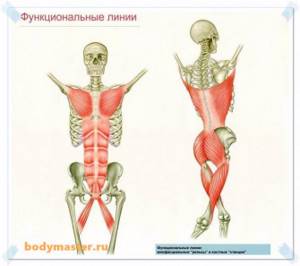
Finally, your recuperative repertoire should include a relaxing massage for athletes at least once a week.
How to properly pump up body muscles
Having dealt with training, let's look at how methods of varying intensity and alternating loads shape our muscles.
Increasing training intensity
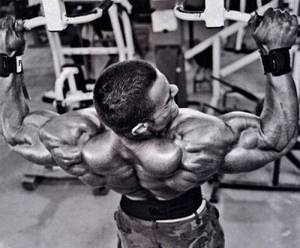
Let's figure out how ways to pump up muscles with training of varying intensity can lead to the formation of a sculpted body. The need to constantly increase the intensity of training is ignored not only by the average gym goer, many experienced bodybuilders and competition participants also do not understand it. No matter what your fitness level, you all need to remember one thing: intensity is the key to progress.
If you do 4 sets of 10 reps of squats every day with the same weight for several months or - scary to think - years without trying to increase the intensity of the training, then you will not see strong muscles. Simply because your body will not put any effort into changing muscle size.
Just because you gain a little size after a workout doesn't mean you're stimulating muscle growth. This is especially important for experienced athletes, because after people have trained consistently for years, extreme measures must be taken to significantly improve performance and build huge muscles.

When it comes to preparation, the term "intensity" takes on many different meanings. When designing a workout, it is necessary to increase and decrease the intensity of the program in all its forms to pump up the muscles and avoid overtraining.
To do this, monitor your body condition daily, do orthostatic tests, especially after hard days. Knowing how your body reacts to different levels of intensity will allow you to use many different methods to increase muscle growth and properly tone your body.
Load planning
It is believed that for muscle size it is better to work with heavy weights in a small repetition range. This type of load will allow you to improve your strength, but you can’t expect a huge increase in muscle mass from such training.

The second option is to work with light weights and high reps. In this case, you increase muscle hypertrophy, leaving strength indicators at the same level.
It is a mistake to work only in one range, using only one type of load. A serious training program for experienced athletes should include heavy, medium and light loads.
To build muscle over a long period of time and make progress, use the progression method.
Increasing the maximum weight used for both high and low repetitions should be the ultimate goal of any training program, because this alone is one of the most important factors in pumping up huge muscles in the body.
Volume increase
The volume of strength training is the sum of the exercises performed and the weight of the weight. If your goal is to maximize volume and build huge muscles, use high intensity and high volume training. This will allow another mechanism to be involved in the process - hyperplasia.
Unlike hypertrophy, which increases the size of your existing muscle cells, hyperplasia helps increase their number.
However, despite such super efficiency, a sharp and frequent increase in the number of approaches and repetitions can cause overtraining.

The best option here is to maximize muscle growth with high-volume training and do periodic low-volume training to ensure your body can keep up with the muscle-building demands you place on it.
Muscle failure

The set will simply continue until the point where another repetition can no longer be completed correctly without the help of a spotter partner. Training to muscle failure helps achieve more impressive results than with approaches stopped early. Although working to muscle failure is more effective, stopping the set shortly before failure can also produce large amounts of growth.
This is because the determining factor for muscle growth is overload, not failure. Constantly lifting heavy weights for varying numbers of repetitions will overload the muscles and speed up adaptation.
So how should you train? Strength growth does not always move steadily upward at an even pace; often its changes are similar to the ebb and flow of the tides. Therefore, training programs for experienced bodybuilders should contain both sets to failure and sets close to failure, as well as regular working sets.
Many of the benefits of training to failure can be reaped by performing sets very close to the point of failure. In this case, stopping the approach 1-2 repetitions before failure will sufficiently stimulate the muscle fibers without overloading the nervous system.
Rest periods between sets

Most bodybuilders use standard rest periods that they enjoy, staying within that comfort zone at all times. However, rest periods are another tool that can be used to increase the intensity of your workout and effectively pump up your body.
The length of rest between sets is directly related to how much energy is available to the muscles at the beginning of the next set. Rest of about 3 minutes after the approach allows the muscles to recover almost 100%, thanks to which you can use almost maximum weight in each approach.
This is why athletes involved in strength sports rest for so long between approaches. The use of long rest should be especially included in the training program for beginner bodybuilders, as this will help achieve progressive overload, and therefore the desired development of muscles throughout the body.
However, shorter rest periods of 60-90 seconds will restore approximately 85-90% of energy while having a greater impact on growth hormone levels than longer rest periods. Short breaks work great if the training is targeting hypertrophy with moderate to low load, high reps and high volume.
Research shows that the most dramatic increases in growth hormone occur when pumping muscles with a minimum of 10 reps per set and rest periods of 45 to 60 seconds.
If you want to experience consistent, sustainable muscle growth for years to come, remember these basic principles of load, volume, rest time and failure, and adjust them as needed.
Where to train
The above exercises can be performed without the use of any equipment, a maximum of one or two chairs is needed, but some exercises require a horizontal bar. It can be purchased at any sports store and installed in the doorway, but if this is not possible, then you can practice on the outdoor sports ground. They are usually equipped with everything necessary for athletes.
You can pump up at home, although not as easily as in the gym. You should adhere to proper nutrition and do not forget about safety precautions during training.
It's possible to build muscle in a week
.
If you train and eat optimally, you can literally get bigger and stronger with every workout. Some books describe cases where people built muscle mass up to 10-15 kg in just 10 weeks (without steroids). Of course, you are unlikely to be able to gain even 3 kg in one week, but gaining at least 1 kg is quite possible. Follow the simple steps below to build muscle within a week
or less.
Step 1
Do three workouts in a week
. For example, on Monday, Wednesday and Friday. Simplify your workouts by using just one exercise per muscle group. You need to perform the exercises to failure until you can no longer do repetitions. Add weight gradually, in increments of 5-10 kg. Try the following program: Monday - legs, back, chest and shoulders. Wednesday: Legs, triceps, biceps and calves. Friday: legs, back, chest and shoulders.
Step 2
Use basic exercises
, which involve several muscle groups and involve a larger number of muscle fibers. Exercises such as squats, deadlifts, bench presses, dips, pull-ups, and standing presses work best. One or two sets to failure (after 1-2 warm-up sets) will be enough to induce muscle growth.
Step 3
During the negative phase
While performing the exercise, you must also tense your muscles and relax them very slowly. Do not lower the barbell or dumbbells too sharply; the more often the muscles are involved, the better.
Step 4
Use 9-12 reps
in each set to induce muscle hypertrophy.
Exceptions are the calves and forearm muscles
, which require
12 to 30 repetitions
due to their high endurance.
Step 5
a protein shake after your workout
! Remember that muscles do not grow in the gym, but only when we rest does our body receive enough nutrition and protein to repair damaged muscles. The ideal ratio for a shake is: 50 grams of protein (whey), 100 grams of carbohydrates (glucose or fruit juice) and 30 grams of fat (flaxseed oil). These nutrients will be used to repair your muscles and allow you to build muscles for your next workout.
Step 6
You need proper rest
. Sleep 7-8 hours every day and go to bed no later than 10 pm. During sleep, the body releases important anabolic hormones, such as growth hormone, which promotes muscle growth.
Step 7
Buy Creatine Monohydrate
and consume 5 to 10 grams daily. Creatine is a natural and very effective muscle building agent. This element allows you to pump up your muscles with water, creating an anabolic state and making you physically stronger and bigger. Although this will be liquid weight, you will be able to gain weight.
In ten days, the caterpillar turns into a beautiful butterfly. And what can a person who sets a goal to improve his own body achieve in one month? If you take as a basis an ideal diet, as well as an impeccable training program, and follow a certain regimen, then even in a month you can significantly change your physical shape.
Is it possible to build muscle at 40?
All of these aspects of training depend on each other, and if one is adjusted, then all the others must also be adjusted accordingly. Those who aspire to be true bodybuilders must be more conscious when increasing the intensity of their training.
This set of recommendations gives the most complete picture of strength training technology and opens the doors of the gym for both young and older athletes. There is no restriction to start building muscle at 40 or 50 years old.
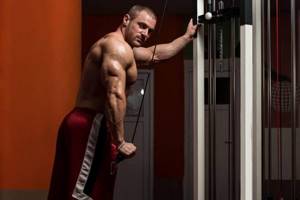
Getting pumped up and sculpted muscles for a man or woman after 40 years of age is no more difficult than for a young person. More often than not, older athletes are more disciplined, while younger athletes find it more difficult to put together a training program. A person with an established career can afford sports supplements and the right amount of rest time and massages, while young guys are most often limited in this.
The human body easily adapts to everything, and if new conditions are not given to it, it will have no incentive to change. Try to create a plan that challenges you with its high intensity and have fun training.
Still in doubt? Watch the training of Alexander Yashankin, one of the brightest popularizers of bodybuilding in the CIS.
Sports nutrition will help speed up the process of quickly pumping muscles - proteins, creatines, gainers, arginines, BCAA, amino acids. These supplements are specially designed for athletes and fitness-active people of different fitness levels. Such drugs are completely safe, and their effectiveness has already been proven.
